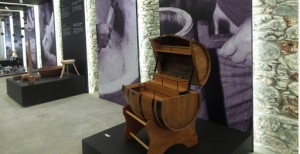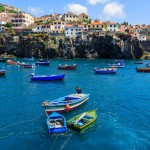Discover the enchanting culture and traditions of Madeira!

Madeira Island is one of Europe’s most beautiful travel locations with many thousands of tourists returning year after year. Why?
That’s because Madeira is not a typical holiday destination, it’s more than that, it’s a marvelous location to go out and explore, to immerse in the local culture and to discover its roots, spirit, customs and traditions of Madeira!
Madeira is famous for its all year round summer climate, fauna and flora, exquisite cuisine, astonishing touristic attractions, but maybe you didn’t know that it’s also famous for its spectacular embroidery tradition and impacting profound handicraft.
Despite its isolated location, Madeira has maintained a good cultural autonomy.
This is reflected in the language and in traditions that have learned to deal with the combination of different elements coming from various countries who have accepted Madeira´s emigrants.
Madeira´s crafts are of great importance to the economy of the region. You can admire the art of embroidery and weaving in many of Madeira´s villages and discover its charm by visiting the The Madeira Wine, Embroidery and Handicraft Institute, settled in the old headquarters of the Madeira Embroidery Industrial Association, opened in 1958, by the architect Fabrício Rodrigues.
The Museological Center of the Institute of Wine, Embroidery and Handicrafts of Madeira (IVBAM) is a space dedicated to the history and culture of Madeira Embroidery, seeking to recreate the romantic atmosphere of a house on the island of Madeira, paying homage to a secular art and offering the visitor a display of pieces produced over 150 years.
The museum center contains pieces of furniture from the 18th and 19th centuries, Hepplewhite, Sheraton, in the Victorian style. It also brings together a collection consisting of pieces of Madeira Embroidery, produced between the 1960s and the 1930s.
The Madeira Embroidery is one of the world’s best and was often purchased by royal houses of Europe over the past 100 years. The secret is in the plight of the designs and the high quality of the parts that only receive the guild seal of Madeira Embroidery Institute after rigorous inspections.
One of the driving forces behind this activity was Miss Phelps. She was the daughter of an English merchant, who came to Madeira in mid 1850. Impressed by the manual ability of local women, taught them the techniques of broderie anglaise. Quickly assimilated these teachings, Miss Phelps sent some of the first pieces to England, and then rained down orders. She started up a new art on the island.
The Madeira embroiderers were so competent and original that three decades later they had imposed a style that would become known as madere broderie. Embroideries brought a new source of income for thousands of families. In 1906 there were 30,000 embroiderers in rural areas, which joined the two thousands of professional embroiderers in Funchal. Most of the work was done at home, with the final finishes made in Funchal factories.
The World War I, the appearance of other foreign companies competing for the place of the lucrative German companies and the Americans of Syrian origin who came to dominate the industry, flooding the world market with low-quality cushion covers, led to a negative effect on the image of Madeira Embroidery and decreased sales between 1916 and 1925.
In 1925, two American entrepreneurs, Charlie Rolland and Leo Behrens invested in the recovery of the Madeira Embroidery quality. They created the Imperial Linens Company and introduced new techniques inspired by the embroidery of other European countries such as Italy, Switzerland, Spain and France. They introduced new motifs and designs taking as model the flowers and other plants of Madeira and added feathers, shells, marine motifs and scenes of daily life in Funchal. Thanks to this renovation, it was born the Madeira embroidery as we know it today. One of the most famous pieces of the Imperial Linens Company was the tablecloth Princess Grace, designed by the talented German designer Herman Klein, at the wedding of actress Grace Kelly to Prince Rainier of Monaco.
The art of craftsmanship is a special one, as unique handmade pieces of art are forged out of imagination, love, dreaming and beauty.
The wickers grow in wet valleys near streams, in places like Camacha, Santo da Serra, São Vicente, Faial and São Jorge. The sticks are cut close to the ground in the first months of the year and put into water to germinate. After peeled and left to dry, they are ready to be worked. The craftsmanship of the lintel has secular traditions on the island.
An example is the conical baskets used to transport the grape, called barraleiros. However, the manufacture of wicker furniture only began in the nineteenth century. The industry wickerwork started in Camacha around 1850, when many English families living there had their cottages. William Hinton brought Italy furniture and asked local craftsmen to take that as a model. They proved to be perfect in this art and soon they began to sell furniture and rattan cane to the top hotels in Funchal and export to Germany and England.
Currently the Camacha parish continues to be the center of this activity. If you pass the Clock Coffee “Cafe Relogio” can see skilled craftsmen dedicated to their work. Among the artifacts produced are chairs, tables, baskets, baskets, animal sculptures, shelving and more. Many of these parts are exported to the United States, South Africa, Canada and Italy.
This is magical piece of heaven with a volatile atmosphere, surrounded by unique pieces of authentic pure art made by the hands of very talented people.
If you want to discover this rich unique culture and if you want to admire this remarkable art, Madeira is the greatest place for this! Discover this mesmerizing place, always counting on Funchal Airport Transfers or Madeira car hire for beautiful adventures and unforgettable memories!
Comments
by

 English
English Português
Português Français
Français Deutsch
Deutsch Español
Español Whatsapp Chat on +351.916053420
Whatsapp Chat on +351.916053420
 Call center on
Call center on 



